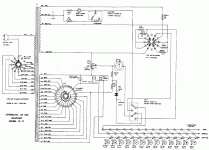The Heathkit IT-17 tube tester has a section on testing unknown tubes; it ways to hold the line adjust short test switch in the test position, and adjust the plate control to bring pointer to the middle of the good scale. Is there a more accurate way of testing the plate setting on my tester? Perhaps setting it to the same number as a similar tube?
Having the manual in-thread would be good.
https://www.vintage-radio.info/download.php?id=516
The manual clearly says "If possible... three new tubes of the same type and select the average setting". I can't see what trimming mid-scale on one tube of unknown condition can possibly tell you?
If you know a "similar tube", that seems like a good plan.
Remember that tube testers will sometimes flag a tube which is BAD (I found a hot-short in a tube that seemed un-shorted when cold), but they can never prove a tube is "good".
The IT17 is, as said in the manual, an emissions tester. It ties all electrodes except cathode together and flows maximum current. The manual is clear about the other ways to shop-test tubes. The emissions tester is considered the cheapest tester. Some tube sellers will not accept returns if they know you have used an emissions tester, because you can deplete a cathode quickly.

https://www.vintage-radio.info/download.php?id=516
The manual clearly says "If possible... three new tubes of the same type and select the average setting". I can't see what trimming mid-scale on one tube of unknown condition can possibly tell you?
If you know a "similar tube", that seems like a good plan.
Remember that tube testers will sometimes flag a tube which is BAD (I found a hot-short in a tube that seemed un-shorted when cold), but they can never prove a tube is "good".
The IT17 is, as said in the manual, an emissions tester. It ties all electrodes except cathode together and flows maximum current. The manual is clear about the other ways to shop-test tubes. The emissions tester is considered the cheapest tester. Some tube sellers will not accept returns if they know you have used an emissions tester, because you can deplete a cathode quickly.

I'm comparing the spec sheet for the 8045G to 6550(KT88), since I don't have 3 tubes. on the 6550, the plate voltage for average characteristics is 250V, or 21 position on the plate dial from the scroll. Thee 8045g spec sheet translates partially to 2 tables for plate voltage:
Maximum characteristics 550v and static charactersitcs 200v; Would average and static mean the same thing on a data sheet; would a plate setting of 19 be correct to test the 8045G?
Maximum characteristics 550v and static charactersitcs 200v; Would average and static mean the same thing on a data sheet; would a plate setting of 19 be correct to test the 8045G?
Haven't decided yet. Possibly build a PAAre you trying to sell 8045G, or do you have an amp using them, or ?
If you had a donor amp that could fit one and had easy bias control, then idle operation could confirm idle operating point, and various tests could confirm operation at reduced heater voltage, and input grid leakage. If you had more than one then you compare those idle conditions.
If you only have one, then putting a lot of effort into building with it is a risk since you cannot replace it, and you cannot be sure how strong the tube is.
If you plan to sell it and you measure it and you discover it is not strong, then IMV that makes for a much tougher sale since now you can sell it 'in good faith, untested with no guarantee'.
With these less common tubes I reckon for a stereo push pull amp you really need 12, so you can match wthin reasonable tolerances, and have a spare set.
I acquired a lot of tubes with a tube tester I bought, and there are about 500 types of tube in the collection. A lot of them look like interesting candidates for experimentation, but if I only have 1 example then it is pointless, so I will try and offload the ones for which I don't have a minimum of 4 examples.
Unfortunately it is not so easy repatriating these singleton tubes with their brethren.
If you plan to sell it and you measure it and you discover it is not strong, then IMV that makes for a much tougher sale since now you can sell it 'in good faith, untested with no guarantee'.
With these less common tubes I reckon for a stereo push pull amp you really need 12, so you can match wthin reasonable tolerances, and have a spare set.
I acquired a lot of tubes with a tube tester I bought, and there are about 500 types of tube in the collection. A lot of them look like interesting candidates for experimentation, but if I only have 1 example then it is pointless, so I will try and offload the ones for which I don't have a minimum of 4 examples.
Unfortunately it is not so easy repatriating these singleton tubes with their brethren.
Hey Guys
Thanks for the responses.
Right now I have 2. I Don't have a amp that I could Try them on.
I was hoping Someone could help by answering some of my questions in post #3
Thanks for the responses.
Right now I have 2. I Don't have a amp that I could Try them on.
I was hoping Someone could help by answering some of my questions in post #3
- Home
- Amplifiers
- Tubes / Valves
- Testing 8045G Tubes on a Heathkit IT-17 without scroll data